
Infrapatellar bursitis occurs when one or both of the bursa sacs inside the knee become irritated and inflamed resulting in swelling and knee pain. A bursa is a sac of synovial fluid, rich in protein and collagen. These fluid-filled sacs are located in areas where 2 surfaces in your body, most often where a bone and tendon or a bone and muscle, rub together during movement.
There are 2 infrapatellar bursa in each knee, the deep infrapatella bursa and the superficial infrapatella bursa. The deep infrapatella bursa lies below the kneecap between the patella tendon and the upper front surface of the tibia (shin bone). The superficial infrapatella bursa acts as a cushion between the patellar tendon and the skin.
If you are suffering from infrapatellar bursitis, you may be experiencing swelling and tenderness, pain, limited range of motion, weakness, and possibly a fever if the bursa is infected.
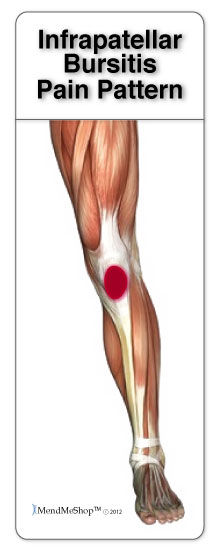
Knee Pain - you may experience pain and tenderness over top of the kneecap as the bursa sits over the kneecap. The pain may radiate down your leg to the mid-calf. Due to the location of the bursa, pain will make kneeling difficult. This type of bursitis is also called Clergyman's Knee because it was a common condition among clergymen kneeling for prayer.
Bursitis pain becomes worse during exercise or when you are climbing stairs, but can also increase by simply bending and straightening your knee. The knee pain caused by bursitis usually starts gradually and develops over a few days or even months.
Difficulties Sleeping - Patients suffering from knee bursitis may also have interrupted sleep patterns. Simply bending your knee or rolling over during sleep can cause pressure on the inflamed bursa, increasing your pain. The pain can range from mild to very sharp depending on the amount of swelling and inflammation in the bursa. Many knee bursitis sufferers recommend placing a pillow between your knees/thighs while you sleep to reduce pain throughout the night.
Swelling, Tenderness, Warmth, and Redness - Swelling is usually evident with infrapatellar bursitis and often appears as an abscess over or below the kneecap. This swelling may appear immediately following trauma, over a couple of hours, or up to 7-10 days after the event that caused the irritation.
You may also notice warmth and visible redness on your skin in the area as inflammation in the bursa and along the tendons becomes more severe.
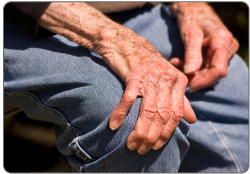
Limited Range of Motion and Weakness - Pain often limits your knee movements as you stop performing motions that make the pain worse. If bursitis is left untreated the inflammation can increase, causing more pain, limiting movement even more. Eventually, weakness in the leg muscles and and tendons around the knee can set in. As you lose strength in your quadriceps, your legs may begin to give out during daily activities.
When you are experiencing knee pain, a visit to the doctor is always recommended, as there are many conditions that can cause knee pain such as a meniscus tear, an ACL sprain, patellar or quadriceps tendinitis, a fracture, and yes knee bursitis. Getting a proper diagnosis is important so you can treat your condition correctly.
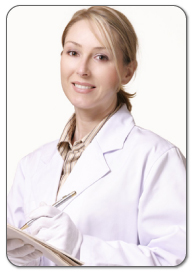
To begin with, your doctor will gather a medical history about you and your current condition and symptoms. He/she will ask about the amount pain you are having with your knee. How long you have had your symptoms and if you are have range of motion loss with you leg and knee. Details about what caused the pain in the knee, when it started, and whether or not you have ever had treatments for this or a similar condition in the past, are very helpful in assessing your injury.
A physical examination will be performed to determine if you have any signs of knee bursitis or other knee injury. He/she will visually assess and palpate (feel) the bones and soft tissue in both your knees to evaluate any differences between the two of them. This will identify any abnormalities, such as swelling, bone deformities, atrophied muscles, redness and/or warmth on the skin. In many cases, the first sign that you have knee bursitis is swelling at the joint.

If a soft tissue injury is suspected, an MRI will likely be done to view where and how extensive the damage is. An x-ray may be recommended to rule out a bone spur or other foreign body as the cause of your knee pain.
As the bursae in the knee are close to the surface of the skin, they are more susceptible to septic, or infectious, bursitis caused by a cut or scrape on the knee. Septic bursitis requires antibiotics to get rid of the infection. Your doctor will be able to determine whether there is an infection or not by drawing a small sample of the bursa fluid with a needle.
Inflammation of the infrapatellar bursae or the surrounding tendons (quadriceps tendon and patellar tendon) usually develops due to overuse, trauma, or degeneration of the protective tissue in the knee. Specific causes include:
Acute Trauma - A direct blow to the knee, at the top of the tibia, can cause injury to the infrapatella bursa during athletics or when falling on the knee. In such cases, blood may leak into the bursa causing irritation, inflammation, swelling and pain.
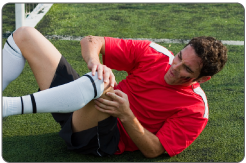
Excess Stress - Without exercise or activity, muscles can weaken and your knee no longer has the muscle support it needs to move correctly. This can cause excess load on the knees and hips or your weight may be distributed unevenly within your knee joint. Uneven distribution of weight will put extra stress on some areas compared to others leading to abnormal wear and tear on the stressed areas.
In addition, if you are overweight, the knee joints have to work harder to carry a greater load causing more stress on the tendons, ligaments, muscles, bones, and bursae in the knees. The excess stress can lead to irritation and inflammation of any of the soft tissue over time, including the infrapatella bursa.
Overuse Injury (Chronic) - Excessive friction, or rubbing, on the infrapatella bursa can aggravate it over time. If your work or exercise routine requires frequent climbing, running, jumping, or hiking you may be at higher risk of infrapatella bursitis due to the frequent knee bending. This risk increases if there is anything that many cause abnormal wear and tear within the joint.
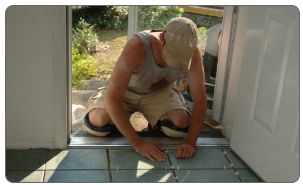
Pressure on the Bursa - Work and frequent activities that place repetitive pressure on the infrapatellar bursa can cause infrapatellar bursitis. Although the bursae in your knee function as cushions to protect the tendons and other soft tissue, frequent kneeling during your work or activities often creates more stress than they can handle. The excess pressure causes the bursa to become irritated and inflamed, leading to swelling and thickening of the bursa lining. When kneeling on hard surfaces, knee pads are recommended to treat or prevent infrapatellar bursitis.
Infection (Septic Bursitis) - The closer the bursa is to the surface of the skin, the more likely the chance of infection from specific bacteria that are commonly found on the surface of the skin. This infection is known as septic bursitis and common bacteria that create this infection are known as Staphylococcus Epidermis (or Staphylococcus Aureus). This bacteria can affect the bursa if the knee is cut or scraped, allowing it to get under the skin.
The good news is that most cases of knee bursitis will heal with simple home conservative treatments and surgery is often not needed!
First you need to stop the activity that is causing your pain and rest your knee. Focus on treating the symptoms of your bursitis and any other soft tissue injuries you may have in your knee. Make sure to completely reduce inflammation, tenderness and swelling-induced pain first before switching to a goal of healing your bursitis injury.
With bursitis injuries, you might feel the swollen and tender feeling for a long time and it will be hard to treat your condition because your bursa will be sensitive to all other therapies outside of cold compression. When introducing other therapies make sure to treat with cold compression to reduce any lingering affects of the inflammation and then an hour or so later give your bursa a soothing TShellz Wrap® treatment with the goal of increasing blood flow in the area while relaxing soft tissue surrounding your bursa.
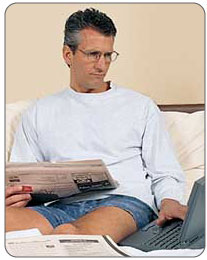
RICE (Rest, Ice, Compression, Elevation) has been recommended for years by doctors, trainers, and other medical professionals to treat the pain and swelling, chronic pain from injury and after any re-injury. Bursitis injuries need rest and time for the tissue to heal.
An ice pack or frozen bag of peas will help you minimize pain and swelling of the bursa. Cold works by interrupting and slowing nerve and tissue function in the damaged area. This is important because once blood vessels are damaged, they can no longer carry oxygenated blood to the damaged PCL so this tissue begins to break-down.
Cold temperatures slow cell function thereby reducing cellular break-down. Furthermore, because the cold numbs the nerves, it will help reduce pain.
Once the inflammation of your bursitis has been reduced with a Cold Compress or Ice Pack it is time to start Circulatory Boost treatments with the TShellz Wrap®. Regular treatments with the TShellz Wrap® will improve blood flow and improve the elasticity of your surrounding soft tissue. Your body needs a fresh supply of blood to improve the health of your tissue and get your knee bursae and tendons back to normal.
Unfortunately, when you are suffering from bursitis it can be painful to even walk or lift your leg. When you limit movement in your knee joint the blood flow is reduced, starving your tissue of the necessary oxygen and nutrients.
The trick is to find a way to increase blood flow without causing pain and/or further inflaming the bursae. This is where Circulation Boost, or Circulatory Boost, becomes a powerful tool.
Circulatory Boost compliments your body's natural healing process by promoting blood flow while you give your knee the rest it needs.
The Knee TShellz Wrap® uses a process to generate Energy - the same energy that is part of the sun's spectrum of light, the same energy that is necessary to all living things for optimum health. The energy emitted from the Energy Pad reaches into soft tissue, stimulating blood flow to your knee, more than your body would ever be able to generate on it's own, giving your body the boost it needs to continue the reconditioning process. The effect of this energy increases blow flow in the area, speeding up the bodys tissue repair process while whisking away toxins and dead cells. The intent of a TShellz Wrap® treatment is to rejuvenate soft tissue in the knee while improving the elasticity of muscles, tendons & ligaments.
Click HERE to Go To Our Online Store We take all major credit cards and Paypal. If you are on your mobile phone, Click to Call Our Office (toll free continental NA).
Our customer service lines are open 5 days a week helping people understand their injuries and how to treat them. Simply call toll free 1-866-237-9608 to talk with one of our knowledgeable Product Advisors. They have the ability to answer questions and even put together a treatment plan for you.
Product Advisors are available 9:00 am to 5:00 pm Eastern Standard Time Monday to Friday.
Learn more about Knee Surgery and Post-Surgery Recovery
Learn more about how the TShellz Wrap® stimulates blood flow.
Learn more about Ice vs Heat Treatments for Knee Strain
During your recovery, you will probably have to modify and/or eliminate any activities that cause pain or discomfort at the location of your soft tissue injury until the pain and inflammation settle. The more diligent you are with your treatment and rehabilitation, the faster you will see successful results!
Please be aware that this information is neither intended nor implied to be a substitute for professional medical advice. CALL YOUR HEALTHCARE PROVIDER IMMEDIATELY IF YOU THINK YOU MAY HAVE A MEDICAL EMERGENCY. Always seek the advice of your physician or other qualified health provider before using any of our outstanding products to make sure they are right for you and your condition or if you have any questions regarding a medical condition. Always see your doctor for a proper diagnosis as there are often many injuries and conditions (some very serious) that could be the cause of your pain.
© 2025 In.Genu Design Group, Inc. Contact Us